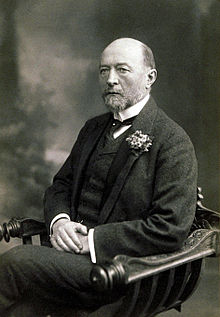Emil Adolf von Behring
| Emil von Behring | |
|---|---|

Emil Adolf von Behring
|
|
| Born | Adolf Emil Behring 15 March 1854 Hansdorf, Prussia (now Poland) |
| Died | 31 March 1917 (aged 63) Marburg, Hesse-Nassau |
| Nationality | German |
| Fields | Physiology, immunology |
| Notable students | Hans Schlossberger |
| Known for | Diphtheria antitoxin/serum |
| Notable awards | Nobel Prize in Physiology or Medicine (1901) |
Emil von Behring (Emil Adolf von Behring), as Emil Adolf Behring born (15 March 1854 – 31 March 1917) was a German physiologist who received the 1901 Nobel Prize in Physiology or Medicine, the first one awarded, for his discovery of a diphtheria antitoxin. He was widely known as a "saviour of children", as diphtheria used to be a major cause of child death. He was ennobled in 1901 for services to medicine.
Behring was born Adolf Emil Behring in Hansdorf (now Ławice, Iława County), Province of Prussia, now Poland.
Between 1874 and 1878, he studied medicine at the Akademie für das militärärztliche Bildungswesen, Berlin. He was mainly a military doctor and then became Professor of Hygienics within the Faculty of Medicine at the University of Marburg (against the initial strenuous opposition of the faculty council), a position he would hold for the rest of his life. He and the pharmacologist Hans Horst Meyer had their laboratories in the same building, and Behring stimulated Meyer's interest in the mode of action of tetanus toxin.
Behring was the discoverer of diphtheria antitoxin in 1890 and attained a great reputation by that means and by his contributions to the study of immunity. He won the first Nobel Prize in Physiology or Medicine in 1901 for the development of serum therapies against diphtheria (which Kitasato Shibasaburo and Emile Roux also contributed to) and tetanus. The former had been a scourge of the population, especially children, whereas the other was a leading cause of death in wars, killing the wounded. He was elected a Foreign Honorary Member of the American Academy of Arts and Sciences in 1902. At the International Tuberculosis Congress in 1905 he announced that he had discovered "a substance proceeding from the virus of tuberculosis." This substance, which he designated "T C", plays the important part in the immunizing action of Professor Behring's "bovivaccine", which prevents bovine tuberculosis. He tried unsuccessfully to obtain a protective and therapeutic agent for humans.
...
Wikipedia
